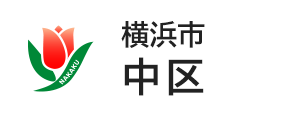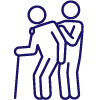Last updated date:2020/3/3
ここから本文です。
Highlight(2019)
We are all one in Yokohama’s Naka Ward! - Living life as you choose in multicultural Naka Ward -
At present, 1 in 10 people in Naka Ward are a non-Japanese resident, and the ratio is increasing every year. Some foreign nationals probably find it difficult to integrate into the community when they first arrive. However, in the course of their daily studies, work and life here in Naka Ward, an increasing number of people have got to know their neighbors and been invited to take part in community activities.
Cultural diversity and communication
Words are of course an important means of communication, but it is not so easy to learn a language that is not your native tongue. We interviewed someone who lives in Naka Ward, who arrived here and had to learn Japanese from scratch, about her experiences.

Ms. Saida Hamada
How long have you lived in Japan?
I have lived here for 7 years. My mother is Japanese and my father is Moroccan, and I was brought up in Morocco. I could not speak any Japanese when I arrived here, so I had to ask things in English. But in many cases people did not understand what I was saying and were unable to answer.
How did you learn Japanese?
I attended a Japanese language school, and also made use of the volunteer Japanese lessons at Naka International Lounge. I asked friends, school teachers and work colleagues when I was struggling to understand something in my daily life, such as the content of letters or notices. From money to dealing with customers, I learned everything from zero at my first workplace.
What are the differences between Morocco and Japan?
The food and living environments are really different. Perhaps the biggest difference is the way people communicate in their communities. In Morocco, everyone knows everyone in their neighborhood, and they are very close. People know who is in which family and often invite each other over for a meal. In Japan, however, I did not know anything about my neighborhood, and at times it felt a little scary to know so little. But Japan is a safe and comfortable place to live. And the longer I live here, the more I feel I come to understand what makes Japanese people tick.
What do you think is important for people to accept cultural diversity and live together in harmony?
I think it is good to find a place where people can communicate on a level playing field away from the hierarchical relations of the workplace. If you can forget differences in position and speak with people in a friendly way, perhaps it is possible to find more common ground.
The local community and multicultural coexistence
The first thing is simply to greet people on the street every day, and from this build the kind of relationship in which everyone helps each other out naturally. More and more local activities are taking place in our community, and there is a deepening sense of solidarity among Naka Ward’s residents.

Ms. Lin Jin Yuan
Coordinator, Nijiiro Tankentai
Nijiiro Tankentai, the organization to which I belong, plans and administers Rainbow Space. Held in Naka International Lounge, this is a place for young people with roots overseas. In addition to facilitating interaction among people and holding awareness-raising events, members of Nijiiro Tankentai help out at local events as volunteer interpreters. We believe our work is meaningful in the sense that we act as a bridge in the community, helping overseas nationals get involved in local activities. And these experiences allow the young people of Nijiiro Tankentai to grow as individuals, too. By encouraging young people who do not feel they have roots in Japanese society to get involved in local events as staff members, it gives them a sense of belonging: that this is the place they want to be. Over time, they are sure to find their place within the local community.
Naka International Lounge, a center for multicultural interaction
Location: 1st floor of Naka Ward Office Annex
Languages: Japanese, English, and Chinese
Days and times: Mon., Wed., Thu., Fri., and Sun: 10 a.m. - 5 p.m. (closed every 3rd Sunday)
Tue. and Sat.: 10 a.m. - 8 p.m.
Naka International Lounge provides multilingual information to assist non-Japanese residents in their daily lives, and works to bring people together as a means of deepening understanding of cultural diversity. As part of this work, it holds a range of seminars and events, helping nurture coexistence between Japanese and non-Japanese residents.
Currently recruiting for volunteers
TEL:045-210-0667 FAX:045-224-8343
Try to find what makes us the same, not different!
The U.S. Department of State FSI Japanese Language Training Center, located in Naka Ward, is an organization providing Japanese language training to American diplomats posted to Japan. We asked Ms. C.A. Conroy, director of the center, about her thoughts on cross-cultural understanding.
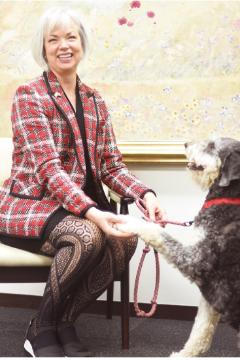
Ms. C.A. Conroy
Director, U.S. Department of State FSI Japanese Language Training Center
With her dog
What are the important things for understanding different cultures and adapting to life in another country?
One of the most important things is to make good friends. In this case, I mean the kinds of friendships built on trust in which your friends do not hesitate to tell you when you make a mistake. When I first came to Japan, I was lucky to have friends who pointed out when I made a mistake in Japanese and gave me advice. These friendships have continued for over 30 years. It is a very special experience to live in a different country rather than just travelling there. While there are times when cultural differences surprise us, the profound feelings we hold during important life events like marriage, childbirth and partings from those we hold dear are the same for everyone. Of course, it can be fun to notice little differences in everyday life. But it is much better to find out what makes us the same and enjoy life together.
Never hand over your bank card! “Your bank card is...” Telephone calls like this are always a scam!
Fraudulent telephone calls have been a major issue in recent years. For instance, there have been cases in which fraudsters call up people pretending to be their child or grandchild and asking to borrow money urgently, or pretending to be City employees and claiming the person is entitled to a refund of some kind. The victim is then directed to an ATM and to transfer money. Such incidents are known collectively as communications fraud. One type of communications fraud that has been on the rise in recent years is a scam in which victims are instructed to hand over their bank card. During the period from January to October last year, there were 19 cases of fraud of this nature in Naka Ward, with a total loss of around 36,000,000 yen. This is the third largest amount among Yokohama’s 18 wards.
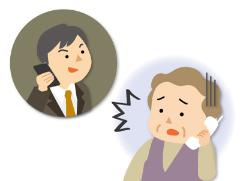
“I am from ●●Bank. Our records show that your bank card is being used for unauthorized transactions. One of our bank’s employees will call at your home and help you complete the procedures to cancel your card.”

“I am from ●●Bank. Until your new bank card is issued, please write down your PIN code on a piece of paper, place it with your card in an envelope, and store it somewhere safe under lock and key.”

“For added safety, we need to make sure the envelope is stamped with your personal seal, so please bring your personal seal.”
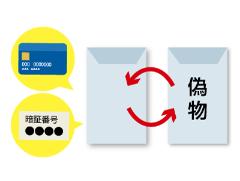
The moment you go to fetch your personal seal, the person switches the envelope for another envelope containing a different card. He then takes the real card and withdraws cash from your account at an ATM.
Criminals use many other disguises than bank employees, including Bankers Association employees, Financial Services Agency employees, police officers, department store clerks, etc. But what they all have in common is that they will use any means to trick you out of your money, such as by telling you that they will take custody of your bank card because it is being used illegitimately, or asking you to send your card in the post. Make no mistake: if the subject of money, your bank book or bank card comes up over the phone, it is fraud. Please report such incidents as these to the police immediately!!
A message from the police
We asked a police officer from the Public Safety Division, Yamate Police Station for some advice.
Recent trends in communications fraud and steps we can take to protect ourselves
As fraudsters call using the names of real government offices or stores, it is at first difficult to tell whether the person on the line is an imposter. Also, there are many cases of fraudsters pretending to be the victim’s son and cheating people out of money through made up stories along the lines of, “I’ve lost my bag...” or “Can you lend me some money until I get paid?” etc. Nobody can tell when they will receive such a call. All you can do is to be ready and know how to act.

First of all, do not make any decisions by yourself. Consult with others! If the subject of bank cards or money comes up over the phone, do not agree to anything on the spot, but seek advice from a family member, friend, neighbor, etc.
Criminals, who by nature do not want to leave traces of their voice, hate telephones with a recording function. If your phone has an answerphone function, make sure it is set to be on at all times and only pick up the phone once you have ascertained who is on the other end of the line.

Another effective step you can take is to use a telephone that is equipped with a function to prevent nuisance calls.
Young people who are coerced into taking part in communications fraud
It is mainly the role of young people to make fraudulent telephone calls or go to collect cards and cash. There have been some cases whereby youngsters were easily coerced into taking part with the promise of money, but got caught out and arrested, and were forced to withdraw from their university as a result. Fraud is a despicable crime that ruins the lives of both the victims and perpetrators. Families, schools and communities need to remain vigilant to ensure that young people do not become involved in fraud.

[Inquiries]
Yamate Police Station TEL/FAX:045-623-0110
Isezakicho Police Station TEL/FAX:045-231-0110
Kagacho Police Station TEL/FAX:045-641-0110
Yokohama Suijo Police Station TEL/FAX:045-212-0110
The dawn of 2020, an exciting year for Japan. Enjoy the Olympics and Paralympics to the max!
Yokohama Stadium in Naka Ward has been chosen as a venue for baseball and softball during the Tokyo 2020 Olympics. With all the action right on your doorstep, it is time to get into the Olympic and Paralympic spirit!
The stage is set for the world’s ultimate athletics event in Naka Ward!
Ryuta Arakawa
Aiming to win a place on Japan’s men’s rowing single sculls team

Please tell us how you first got involved in rowing.
When I entered university, I just happened to be invited to join the rowing club. At that time, I knew nothing about rowing. The rowing club’s PR video was so cool, and I was really taken by the fact that the club was dead set on becoming the best in Japan. With a little more persuasion, I was ready to take up rowing.
What do you find most appealing about rowing?
For me, the best thing is the feeling of exhilaration I get from racing across the surface of the water with the wind in my hair. Rowing requires a person to have a good aerobic capacity, and the amount of training you put in means everything. Therefore, even if you are not so well built, you can become one of the top rowers in Japan if you put in enough effort. In this sense, I think rowing is quite interesting.
Please tell us about your ambitions in terms of Tokyo 2020.
I grew up in Naka Ward, and while I may not be the most athletic of people, I am making steady efforts to try and reach the Olympics. I hope people here will see what I am doing and take a closer interest in the Olympics.
Olympic torch relay celebrations here in Naka Ward!
The Olympic flame, symbol of the Olympics, will set out from Fukushima Prefecture and visit all 47 of Japan’s prefectures over the course of 121 days. On July 1 (Wed.), an event will be held to celebrate the arrival of the Olympic torch at Yokohama Red Brick Warehouse.
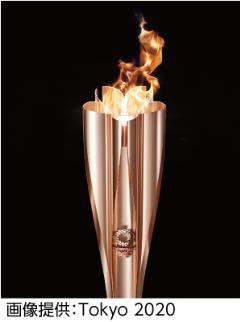
Photo credit:
Tokyo 2020 Olympic torch, which was designed to resemble a cherry blossom
The power of Paralympic sports!
Kazuyuki Kyoya
Assistant coach for Japan’s men’s wheelchair basketball team
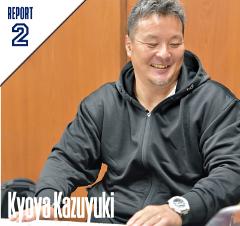
Kazuyuki Kyoya used to be a professional footballer, but a traffic accident left him in a wheelchair. He made his wheelchair basketball debut in the Sydney 2000 Paralympics. He went on to compete in four successive Paralympics. Today, he is the assistant coach for Japan’s men’s wheelchair basketball team.
Please tell us how you first got into wheelchair basketball.
One day, my wife went to Urayasu City Hall, and the person who served her at the counter was a player on a wheelchair basketball team. This person invited me to play wheelchair basketball through my wife.
One time, I went along to a national athletic meet to make up numbers, and it was this occasion that made me see para sports in a totally new light. Until then, I had only thought of para sports as being part of rehabilitation. But I was forced to completely reevaluate this opinion when I saw such amazing athletes in action at the national athletic meet. It was then that I thought I may be able to reclaim some of the pride I had lost from soccer through wheelchair basketball.
Living up to one’s own words
Last year, Mr. Kyoya gave a talk at Yokohama Yoshida Junior High School. The theme of this talk was, “Working towards your dreams.” He talked about his experiences, and had the following advice for students: “Live up to your own words: this is important. Vocalize your goals and take the first step to achieving these goals.”

He put on an impressive display of skill with a clean shot that did not touch the ring.
Bringing together people, things and the region: December 3 to 9 is disability awareness week
Products made by people with disabilities working at day facilities for adults with special needs in Naka Ward are known commonly as “Pore Pore Goods.” You can buy many different items, from handmade crafts and accessories to delicious sweets or bread. This month, we chat with some of the people who make Pore Pore Goods.
Bread
Around 30 varieties of bread! I bake my stuffed bread until it is nice and moist
ギッフェリ (Giffeli)
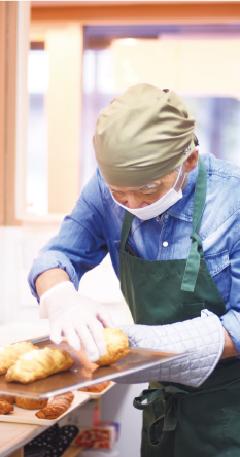
Mr. Katsutoshi Wada
● How long have you been baking bread?
I have already been baking bread for a decade now. I bake my stuffed bread by adding water until it is nice and moist, making it suited to fillings of all kinds.
● How long does it take to bake your bread?
I have the oven on two or three times a day, and it takes about one and a half hours to bake a single batch.
● What kinds of bread do you make?
I make seven varieties of croissant alone. I am really happy when I hear that everything has sold out.
Paper crafts
Creating fun mobiles featuring characters from stories, road bikes etc. and seasonal greeting cards
チャレンジ新生 (Challenge Shinsei)

● Please tell us a little about how you make your items. How long does it take?
Once I have thought up a design, I make a rough sketch on tracing paper. I then place this sketch on a sheet of colored paper and cut around it using a fine cutter knife. It takes me two or three days to complete a piece after I have come up with a design.

● What difficulties do you experience when creating your works? And when do you feel a sense of joy?
I received an order from someone to create a mobile featuring their pet dog. I would have felt really bad if my work looked nothing like the customer’s dog, so I borrowed a photo and poured everything I had into making it. Luckily, the customer was thrilled with the final result, and said it was a spitting image of their dog. I am really happy when mothers with children buy something that has caught their eye.

Mr. Takayuki Goto
Look! We take pride in our work





Where can I buy Pore Pore Goods?
At stores with a permanent stock
Nakana Café (35 Nihon Odori Tel: 045-342-4710)
Market Terrace Café / Kobako Shop (2-64 Ishikawa-cho Tel: 045-264-8370)
At sales events
Naka Ward Office 1st floor: 4th Friday of the month, 11 a.m. - 1:30 p.m. (sales events lasting 5 days also held in June and November)
Aeon Honmoku store (7-1 Honmokuhara): 3rd Tuesday of the month, 1 - 3 p.m.
Honmoku Front (2-100-4 Kominato-cho): 2nd Tuesday of the month, 1 - 3 p.m. (not held in January and August)
Activities born from new forms of creativity
A range of initiatives are currently taking place aiming to create a more inclusive society, one in which anyone can participate regardless of their differences. Here, I will introduce you to SLOW LABEL, an NPO which brings together citizens, businesses and local government to create diversity and harmony through the power of art.
SLOW LABEL, which was established in 2011, is based in Zou-no-hana Terrace. It started producing and selling a range of one of a kind handmade accessories through a collaboration with welfare facilities, artists and businesses.
In 2012, SLOW FACTORY started up as a hands-on workshop in which anyone can take part and meet a diverse range of people living in the local community, irrespective of whether or not they have disabilities. It also gave rise to collaborative projects with the local community, such as Kanazawa Fishing Port.

Ms. Yoshie Kurisu, director of SLOW LABEL
You are not alone. - Here, we introduce you to people in the community that you can turn to for support in raising children. -
Raising children is in many ways a joyous and fun experience, but it also comes with a whole range of worries and concerns that parents often shoulder alone. If you find yourself with a lot on your mind, why not step outside? In Naka Ward, there are many people waiting to lend a helping hand.
Community childcare salons
These are places where guardians and children can come freely for a chat and to play together. Child welfare volunteers are also on hand for consultations.
Consultations while children play
Minosawa Childcare Support Group is held in Minosawa Community Care Plaza. Here, you can also receive consultations from a nutritionist on baby food and children’s diets.
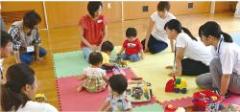
Children can have fun playing with a variety of toys and games.
Some guardians who attend these sessions also have older children, making them a great place to find out and exchange information on day care centers and kindergartens. Please feel free to stop by and get involved!

Ms. Asai and Ms. Hasegawa
District 6 child welfare volunteers
● Minosawa Childcare Support Group
Held the second Thursday of every month, 10 a.m. - noon
Community learning group for children with disabilities
This is a place where children with physical disabilities or children experiencing developmental issues or other concerns can come to receive basic training for daily life and become integrated within the community.
Share the same worries with others
チューリップ (Tulip), a community learning group for children with disabilities held at Furo-cho Community Care Plaza and other locations, is a place for children to come and learn important life skills and play in groups, and for guardians to get to know each other and exchange information, etc.

Ms. Fukaya and Ms. Yamaoka
チューリップ (Tulip) volunteers
Kodomo shokudo (cafeterias for children)
These are places where members of the local community, both adults and children, can come and enjoy a meal in a safe and comfortable environment.
“Welcome back!” A relaxing place where people greet you with a smile
満福うえのまち食堂 (Manpuku Uenomachi Shokudo) prepares meals for around 70 people twice a month. On these occasions, adults can eat for \300 and children for \100. This cafeteria is run with the cooperation of local people.

Ms. Aoki
Founder of満福うえのまち食堂 (Manpuku Uenomachi Shokudo)
● 満福うえのまち食堂 (Manpuku Uenomachi Shokudo)
Every 2nd and 4th Tuesday of the month, 5 p.m. - 8 p.m.
Odekake Spot Map
This map contains easy to understand information on places to spend the day (childcare support facilities within Naka Ward). It also gives you advice on making the most of your day out, how to spend rainy days, and other things.
*A Chinese language version has also been published.

Consultation services
Yokohama childcare partners
(Community Childcare Support Center のんびりんこ (Nonbirinko))
Yokohama childcare partners (full time support staff) will sit down with you and help you think through any worries or problems you may be experiencing in the course of bringing up children. In addition to providing you with the information you need, they will also refer you to local facilities and support services. Please feel to get in touch, whether in person while your children are playing in the plaza or over the phone.
Tel: 045-228-8330 (Yokohama childcare partner hotline)
When: 10 a.m. - 4 p.m., excluding Sundays, Mondays and the New Year vacation season
Grandma Day Care Centers
There are 35 Grandma Day Care Centers in Naka Ward. These are day care centers that open up their grounds to children to come and play, even if they do not attend that day care center, and where guardians can come to talk about their child rearing concerns.
*The content of services and available times differ depending on the day care center.

Miharashi Ponte
This is a consultation service for people in the community living with disabilities and their families. Consultations are available in person by visiting the center or over the phone.
Tel: 045-628-1343
When: Monday - Friday, 9 a.m. - 5 p.m.
Child and Family Support Consultation Desk
This consultation service, located within Naka Ward Office, deals with child rearing issues for children of all ages, from 0 - 18 years. Please do not hesitate to come for advice.
Tel: 045-224-8345
When: Monday - Friday, 8:45 a.m. - 5 p.m.
Yokohama Child Abuse Hotline
Please call if you are experiencing worries or problems raising children, or to report possible child abuse.
Tel: 0120-805-240 (available 24 hours a day 365 days a year)
I want to live in my home and neighborhood forever! – Opting to receive medical treatment or care at home –
How would you reply if you were asked where you would like to spend the later years of your life? Everyone has their own ideas and preferences, so there is no one answer. One of the answers you may give is that you want to continue living in your home and neighborhood for the rest of your life.
The Integrated Community Care System and Naka Ward
The Integrated Community Care System is a system of mutual support within the community which allows people to continue leading life as they choose in their familiar surroundings right into the later years of their life. Naka Ward is currently actively promoting at-home medical treatment and care, which includes receiving nursing care at home, through collaboration between doctor, dentist and pharmacist associations, care service providers, hospitals, and other organizations.
If you have any concerns or queries about at-home medical treatment or care, no matter how small, please do not hesitate to consult with us!
Naka Ward At-home Medical Treatment and Care Consultation Desk
This service provides consultations on matters relating to forms of treatment and care that you can receive at home. We are on hand to give you a range of advice, from introducing doctors or medical institutions to providing information on at-home treatment and care.
Tel: 045-307-2505 (weekdays, 9 a.m. - 5 p.m.)
Fax: 045-628-3558
Email: naka.soudan@eco.ocn.ne.jp

Harumi Iijima, Junko Koizumi and Reiko Nomura
Naka Ward At-home Medical Treatment and Care Consultation Desk
Community Care Plazas (Integrated Community Support Centers)
Community Care Plazas provide an accessible consultation service for members of the community relating to medical treatment, care and welfare. In addition to providing consultations and undertaking procedures for at-home medical treatment or care, they arrange a number of other services, such as classes on preventative care and improving health. Consultations are open to anyone, so it is better to come along while you are still fit and active.
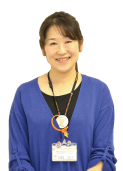
Haruko Yoshimura
Mugita Community Care Plaza (Integrated Community Support Center)
List of Community Care Plazas (Integrated Community Support Centers)
Shinyamashita (みなと赤十字病院 (Minato Seki Juji Byoin Iriguchi) bus stop) Tel: 045-625-1911 Fax: 045-625-1865
Furocho (伊勢佐木長者町 (Isezaki-chojamachi) Station) Tel: 045-662-0161 Fax: 045-662-0192
Mugita (麦田町 (Mugita-cho) bus stop) Tel: 045-664-6023 Fax: 045-664-6075
Honmokuhara (和田山口 (Wada Yamaguchi) bus stop ) Tel: 045-623-0971 Fax: 045-623-0977
Minosawa (根岸台 (Negishidai) bus stop /旭台 (Asahidai) bus stop) Tel: 045-663-6960 Fax: 045-228-1828
Honmoku Wada (二の谷 (Ninotani) bus stop /東福院前 (Tofukuin-mae) bus stop) Tel: 045-622-1211 Fax: 045-622-1290
At-home medical treatment / care: Q&A
Can senior citizens who live alone receive at-home medical treatment or care services?
At-home medical treatment and care services are available to all, whether those living alone or elderly couples. The type of services you will receive depends on your preferences or domestic environment. Please inquire for more details.
What kinds of treatment can I receive?
You can receive a range of treatment at home. For instance, people in the following kinds of circumstances are currently benefiting from treatment at home.
Examples:
● People receiving oxygen treatment
● People who have to wear a catheter
● People with cancer who are receiving pain control through medicine
People can also receive treatment for a range of other conditions through the support of a visiting doctor or nurse.
I am concerned that at-home medical treatment or care will place a burden on my family…
When continuing treatment or care at home, it is important to conduct daily life while making proper use of the available services so as not to put undue strain on family members or caregivers. We will help you think of ways to lighten the load on all concerned, so please consult with us.
Are these services available at night / on holidays?
Services available at night and on holidays include At-home Treatment Support Clinics or visiting nurses who are on standby 24 hours a day. You can receive support for at-home treatment or care through a home visit or over the phone.
I am searching for a reliable family doctor…
If you think you might make use of at-home treatment or care services in the future, we advise you to start searching for a reliable family doctor now. Not even 1 in 10 people will receive a completely clean bill of health during a medical check-up. This is why you should visit a clinic, and if the doctor seems like someone you can trust, you should make this doctor your regular family doctor. Even if this doctor does not provide at-home treatment, if the need arises, he or she is sure to introduce you to someone who is equally to your liking.

Masamichi Niizuma
Head of the At-home Treatment Department, Naka Ward Medical Association
“I’m not a senior citizen yet, but…” Don’t worry! You’re welcome to come along anyway!Senior citizen clubs are great places to learn, improve your health and meet new people!
In order to live life as you wish right into your later years, you need to find somewhere that helps you find a sense of purpose and roles in daily life. By taking part in a senior citizen’s club early on, you can lead a healthy life for longer, and make more friends in the community with whom you can help each other out. So why not try attending a senior citizen’s club?
* Senior citizen’s clubs are involved in a range of activities, such as promoting sports among elderly persons and training people to become supporters for those with dementia.
Inquiries: Naka Ward Senior Citizen’s Club Office Tel: 045-681-8480 Fax: 045-681-8480
44th Naka Ward Festival “Hello Yokohama 2019”

At this year’s Naka Ward Festival, you will find 3 stages featuring jazz and other performances, as well as more than 100 booths with around 25 participating organizations. So please come along and enjoy a fun day out!
* Content is subject to change.
Date: Oct. 13 (Sun.)
Places: Yokohama Park / Nihon Odori Street / Zo no Hana Park
Inquiries: Office of the “Hello Yokohama 2019” Executive Committee (Chiiki Sinko-ka (Regional Promotion Division), Naka Ward Office) Tel: 045-224-8132 Fax: 045-224-8215
Gearing up for the festival
This year will be the 10th year I have taken part in Naka Ward Festival. Every year, I express my love for Naka Ward through my calligraphy performances. I have lived in Naka Ward for 20 years now. For me, it is a home away from home. I am so grateful to be able to live in a safe and secure town that constantly seeks to incorporate new things within its history and buildings going back to those days when Yokohama’s port first opened. I am thrilled to be able to take part in the festival again this year, and am looking forward to seeing you all on the day.

Yuhou, calligrapher
Born in Jiangxi province, China. Chairman of the Japan-China Calligraphy Association, professor at Nanchang University, China
Map
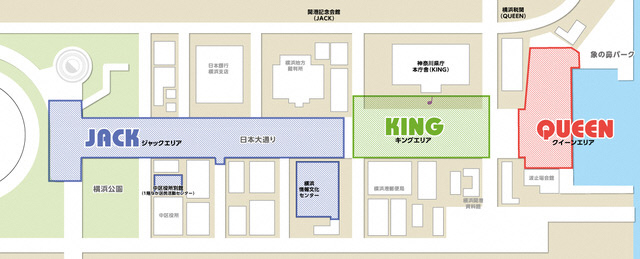
JACK area
In Yokohama Park, you will find a range of booths where you can enjoy things such as children’s games. In addition, Nihon Odori Street will be lined with PR / food & drink booths run by supporting companies and organizations. And there will also be a variety of stage performances, centering on dance, including wind instrument music and a hero show!

Niji no Kai / Kenbi Kai “Naka-ku Minato Ondo”
QUEEN area
In Zo no Hana Park, you will find a range of thematic booths focusing on disaster prevention and the environment, such as a workshop to make magnesium lights that light up when immersed in water.

Magnesium light workshop
A variety of shops from Naka Ward!
A variety of shops from Naka Ward will be running booths on the day, providing food and drink, aromatherapy sessions, and other items for sale.

Honmoku Avenue Business Activative Association “Fujiyamatei”
A special jazz stage coordinated with Yokohama Otomatsuri 2019
Zo no Hana Park will be enveloped in the sounds of jazz music throughout the whole day. Please come along and chill to some jazzy tunes.
KING area
In addition to PR booths for the Rugby World Cup 2019™ and the Tokyo 2020 Olympics, there are also areas where you can have a go at various kinds of exercises. Other booths include those run by organizations active within the ward along with booths to support disaster recovery work.
A range of music in one place, from big band to musicals!

Akai Kutsu / Musical Kids
Other events being held at the same time
Naka Ward Community Activity Center Festival
Organizations registered at the center and Naka-ku Machi no Sensei (Naka Ward Town Teachers) have prepared a range of fun programs for your enjoyment, such as workshops and mini dance tutorial sessions!

Have a go at “Tai chi”
Genki Festa 21 – Extend your Health Expectancy –
Come along and have fun learning about how to improve your health. In addition to health checks and dietary workshops, you can also consult about health and medicine, and find out ways to exercise properly.

Complete the “Health and Exercise Stamp Rally” and receive a special gift!
August Issue - 100th Anniversary of Naka Fire Department
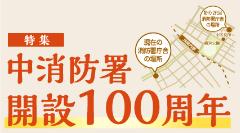
In 2019, Naka Fire Department celebrates its 100th anniversary. This milestone is the perfect chance to think more about what you can do now to protect yourself and the community from the dangers of fire.

First Fire Department building
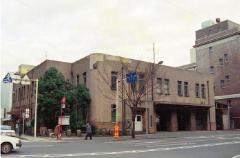
Second Fire Department building

Present day Naka Fire Department
Naka Fire Department 100th Anniversary Festival

There are many different things going on during this festival, including a disaster prevention workshop, fire engines on display, and the chance for small kids to try on a firefighter costume.
Date and times: Nov. 9 (Sat.), 10 a.m. – 3 p.m.
Place: 日本大通り (Nihon Odori Street) (if coming by bus, get off at県庁前 (Kenchomae) bus stop)
Inquiries: Naka Fire Department Tel: 045-251-0119
Learn from past disasters to prepare for future disasters
The causes of fire outbreaks during and immediately after earthquakes have changed in many ways over the ages. During the Great Kanto Earthquake of 1923, many people lost their lives due to fires started by hearths or charcoal braziers. In recent years, around 60% of fire outbreaks during major earthquakes are caused by electricity. Please ensure to install a seismic circuit breaker* to protect your home from electricity-related fires.
* Seismic circuit breaker: A device which cuts the supply of electricity when it detects shaking

Yokohama Port Opening Memorial Hall, a building whose clock tower survived the Great Kanto Earthquake (in the collection of the City of Yokohama Archives)
The Great Hanshin Earthquake of 1995 occurred in the early hours of the morning. Many of the victims were still asleep at home, who became trapped under collapsed furniture, etc. Please ensure to install safety devices to prevent furniture from falling over in the event of an earthquake.

Shopping arcade damaged during the Great Hanshin Earthquake (photo credit: Kobe City)
Learning lessons from house fires which occurred in 2018
In 2018, 274 house fires occurred in the City of Yokohama. Here, we will introduce you to some of the main causes and some of the steps you can take to prevent these.
Cooking stoves: 63 cases
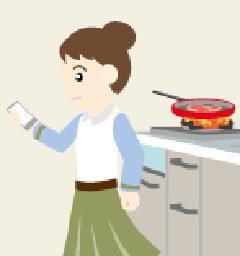
● Do not leave your stove unattended while cooking.
● Tidy up around your stove and make sure to clean it regularly.
Cigarettes: 46 cases

● Never smoke in bed.
● Put water in your ash tray and dispose of cigarette butts carefully.
Arson: 34 cases

● Tidy up around your house and do not leave flammable items lying around.
● Leave out burnable trash and old newspapers on the morning of collection.
Heaters: 16 cases
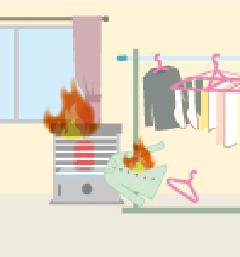
● Do not hang washing above heaters.
● Make sure to turn off heaters before going to bed.
Volunteer fire corps working in the community
Volunteer fire corps, made up of members of the local community, are an important element of local disaster prevention. There are three volunteer fire corps in Naka Ward.
Protecting the community within the community
“There are many senior citizens living in our community. And there are many small children, too. Given this, it is important for members of the local community to know who is living where, and help each other out in times of need. In years past, people were simply told to shout “Fire!” and run in the event of a fire. While protecting one’s own life is of course the highest priority, in recent years more and more emphasis has also been placed on people taking steps to extinguish fires before they get bigger.”

Mr. Yoshio Toyoshima,
Chief of Yamate Volunteer Fire Corps
The circumstances are never the same, so it is important to take part in training
“Within the jurisdiction of Isezaki Volunteer Fire Corps, there are many areas with steep slopes and wooden housing. It is also a thriving area of town with many tourists. Each area has its own set of circumstances, which is why it is important to take part in disaster prevention training and understand more about your area. Our community also has many foreign residents. We need to work together to be ready for disasters.”
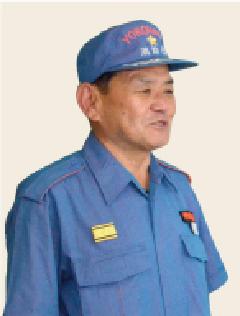
Mr. Jiro Nagata,
Chief of Isezaki Volunteer Fire Corps
Do whatever you can to be ready and help out
“The jurisdiction of Kagacho Volunteer Fire Corps is bustling with people during daylight hours. If a disaster occurs during the day and there are many people requiring assistance, firefighters from the Fire Department and Volunteer Fire Corps will not be able to cope alone. Please make sure to be ready at all times to help yourself and others around you.”

Mr. Junji Miura,
Chief of Kagacho Volunteer Fire Corps
July Issue - Yokohama Kotobuki-cho Health and Welfare Exchange Center opens!

On June 1, 2019, a new civic center opened up in Kotobuki-cho. This facility, which was redeveloped following the rebuilding of the former Kotobuki-cho General Labor and Welfare Hall, serves as place of gathering open to all citizens.
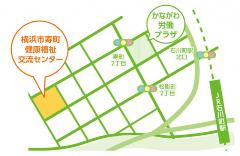
Check out the Center’s new functions!
In addition to the functions available at the former Hall, such as a lounge, reading area, clinic, and public bath, the new Center also provides a range of new functions for citizens to come and use.
* Some services require a reservation following organization registration.
New function 1: Multipurpose room and cooking room / work room
A multipurpose room which can be used for such purposes as light exercise sessions, lectures and meal gatherings. This is adjoined by a cooking room / work room.

New function 2: Health coordination room
A place to come for advice on how to improve your health and wellbeing, staffed by public health nurses, social workers and registered nutritionists. The range of services provided to members of the local community and others includes health consultations and health classes.
"It is our hope that as many people as possible from both inside and outside the ward will come and use the Center, which has been reborn with a whole host of new functions, and that this will help support the healthy lives and well-being of citizens and nurture a range of activities and interactions between people."
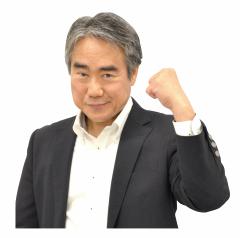
Mr. Junichiro Fujinuma
Director, Yokohama Kotobuki-cho Health and Welfare Exchange Center
Inquiries: Yokohama Kotobuki-cho Health and Welfare Exchange Center
Tel: 045-662-0503 Fax: 045-662-0238
Check out a new community center!
A new center for community activities has opened in the Kotobuki area.
Kotobuki Collaborative Space

Kotobuki Collaborative Space seeks to provide a venue for “open community-building” in the Kotobuki area by facilitating activities and encouraging interaction between people while constructing networks between organizations etc. inside and outside the area involved in community development. Opening day was a resounding success, with an exhibition showcasing Kotobuki past and present and a range of talks encouraging people to think about Kotobuki’s future.
"Our facility aims to be a welcoming place for everyone in the community, a center of collaboration where people can learn about the history of the Kotobuki area and work together to think about its future. We hope that it will help open many doors and bring people together, from those wishing to get involved in local activities and meet people to those interested in volunteering and research activities."

Ms. Midori Tokunaga
Director, Kotobuki Collaborative Space
Inquiries: Kotobuki Collaborative Space
Tel: 045-323-9019 Fax: 045-323-9079
History of the Kotobuki area
Following derequisition from the US armed forces, the Kotobuki area developed into an area of cheap lodging houses for the many day laborers who were the backbone behind Yokohama’s growth. In its heyday, it was a bustling area of town with more than 8,000 laborers, but today the population is rapidly aging and there is an urgent need for welfare services to cope with this. Kotobuki-cho General Labor and Welfare Hall was constructed in 1974 with the aims of securing employment for local people and improving their welfare. The former Hall was a center for medical treatment and sanitation for the community, and also served as a place of recreation. The building was rebuilt so as to ensure conformity with modern requirements for earthquake resistance, and has gained a new lease of life as Yokohama Kotobuki-cho Health and Welfare Exchange Center, which this month celebrated its much-anticipated opening.
June Issue - Welfare commissioners / commissioned child welfare volunteers – Reasons behind their ongoing efforts to put a smile on the faces of people in our community
Welfare commissioners / commissioned child welfare volunteers will be reelected in unison in December this year. In our region, the lack of people to take on these important roles has become an issue.
Meanwhile, there are some people who have been working as welfare commissioners / commissioned child welfare volunteers for many years. “It is tough work, but it is worth it as I feel like I am doing something meaningful.” In what ways do these people find their work meaningful?
About welfare commissioners / commissioned child welfare volunteers
“Welfare commissioners, right by your side.” This is a catchphrase that Naka ward’s welfare commissioners / commissioned child welfare volunteers came up with. But do you know anything about these people who work by our sides in our community as welfare commissioners / commissioned child welfare volunteers?
1. An approachable person in the community you can turn to for advice
Welfare commissioners serve as go-betweens, putting people in the community who are experiencing issues of some kind in touch with the relevant organizations. They are bound by an obligation of confidentiality, so you can talk to them safe in the knowledge that they will not tell anyone else. All welfare commissioners along with commissioned child welfare volunteers work on a voluntary basis without remuneration.
2. A friendly face for children and their guardians
Commissioned child welfare volunteers provide consultations and support for children and expecting mothers. Some welfare commissioners / commissioned child welfare volunteers have been appointed as “chief commissioned child welfare volunteers,” who are qualified to deal with child welfare at the specialist level.
3. Candidates are chosen by people within the community, such as the heads of neighborhood associations
The Mayor of the City of Yokohama recommends candidates that have been chosen by people within the community, such as the heads of neighborhood associations. Candidates then receive a commission from the Minister of Health, Labor and Welfare and start working in their appointed roles.
4. Reelection in unison in December 2019
The term of appointment for welfare commissioners / commissioned child welfare volunteers is three years. In December this year, they will be reelected in unison, something which happens once every three years.
The sight of parents and children is what gives me the motivation to carry on
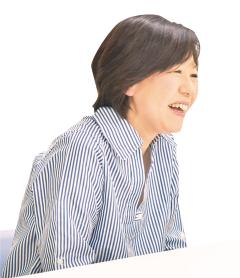
Ms. Naomi Onishi, Honmoku / Negishi area
Go-betweens with the relevant organizations
One thing we chief commissioned child welfare volunteers have been doing on a continual basis is to go out to venues such as “子育てサロン (Child-rearing salons),” “赤ちゃん学級 (Infant parenting classes)” and “親子のひろば (Parent and child plazas).” In the course of interacting with local parents and children in such settings, we get to hear about the worries and concerns of parents – especially those of mothers who are raising children – and provide them with advice. At the end of the day, we serve as go-betweens with the relevant organizations, such as ward offices and schools, so we provide people with information on where to go for advice in accordance with the nature of their concerns.

“親子のひろば (Parent and child plaza)” held in the 2nd floor Japanese-style room of Honmoku Port Heights Center
Children are a treasure for the community
Chief commissioned child welfare volunteers all perform their roles alongside their regular jobs. But even so, they are still able to handle things. One just needs to take care to maintain one’s own lifestyle and engage in things in order of priority.
I feel an immense sense of satisfaction when I see or hear about parents and children who once came to me with concerns walking around in the community and going to school happily. Children are a treasure for the community. I would like everyone to work together in helping raise both their own children and other local children.
Begin by participating in community activities
Mr. Tadashi Ito, head of the 4th Area North Neighborhood Association, who has also worked as a welfare commissioner / commissioned child welfare volunteer. As head of a neighborhood association, he is currently working to solve local issues in collaboration with current welfare commissioners / commissioned child welfare volunteers.
“I am always at my wit’s end when it comes to selecting candidates for welfare commissioners / commissioned child welfare volunteers. All too frequently, I have a suitable candidate in mind but am met with refusal when I ask if this person would be willing to have a go,” says Mr. Ito. “But you could do it if you tried. Our volunteers work at their own pace and gain a sense of fulfillment through their activities.”
“Candidates for welfare commissioners / commissioned child welfare volunteers are chosen from among local people. So please begin by actively getting involved in your neighborhood association’s activities and forging ties with your local community. My hope is for as many people as possible to take on more responsibility for activities in their community.”
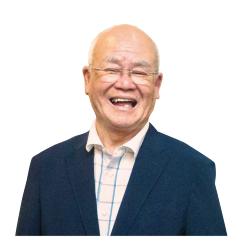
Mr. Tadashi Ito,
Head of the 4th Area North Neighborhood Association
May Issue - 160th anniversary of the opening of the Port of Yokohama – Towards a new era
In June 2019, our city will celebrate the 160th anniversary of the opening of the Port of Yokohama.
Naka Ward in those days served as the stage for a number of major events of a kind frequently mentioned in textbooks on Japanese history, such as the arrival of the kurofune (black ships) from the West. It was also from this time that Naka Ward opened its doors to many new people from all corners of Japan and overseas, embracing new cultures and working together to create a diverse and thriving community for all.
Today, our world is changing at a dizzying pace in terms of society and international affairs. So let us look back at those days when the port opened and compare woodblock prints depicting scenes from yesteryear with the Naka Ward of today, and take a moment to think about where Naka Ward is headed in the future.

Yokohama Kaigan-dori no Zu (View of Kaigan-dori, Yokohama) Hiroshige III, 1870 From the collection of Yokohama Archives of History
A town which brings people together thanks to the opening of the port
Back in the days before the port opened, when our city was known as Yokohama-mura (Yokohama Village), this area was a small farming and fishing village. Located less than a day’s walk away from the capital Edo, neither nearby nor remote.
Many construction workers were attracted here by the prospect of the port’s opening, and once it actually opened, it also brought merchants from all over Japan who came here to trade. People arrived in droves over a short space of time, leading to the development of a new, bustling port town.

Kanagawa Yokohama Shin Kaiko Zu (View of the Newly Opened Port in Yokohama, Kanagawa) Sadahide, 1860 From the collection of Yokohama Archives of History

Present day Honmachi-dori, depicted during the Edo period in a woodblock print. Photo taken in the direction of Yamashita Koen (Yamashita Park) from the Honmachi 4-chome intersection.
This woodblock print depicts Honmachi-dori as it was the year after the opening of the Port of Yokohama. As you can see, it portrays people of all kinds in the same place at the same time, including people selling things, people carrying things such as raw silk, and people shouldering cherry trees for the cherry blossom viewing season. This picture gives us a true sense of just how much of a bustling town it was in those days. Back then, Yokohama was home to foreign settlements and trading houses, and it seems that many people visited simply out of curiosity, coming to see these unusual street scenes for themselves. So, as you can see, Naka Ward has long been a place of convergence for people from all over Japan and overseas.

Mr. Tsukasa Saito
Vice director, Yokohama Archives of History
Inheriting the charms of the Port of Yokohama
I grew up alongside the Port of Yokohama after the War, and have watched it grow over the years.
This port is a symbol of Yokohama, our proud legacy to the world. When the port first opened, many ships laden with cargo of all kinds from across Asia arrived here and loaded their holds with raw silk, which they then transported across the Pacific Ocean. This is because Yokohama had long possessed outstanding cargo handling technologies. From those days onward, Yokohama gained a proud reputation around the world for its technological capabilities.
Every year, we help out with the event “Naka-ku Ko Kuruzu (Naka Ward Children’s Cruise),” organized by Naka Ward Office. This event is held with the wish of encouraging children living in Naka Ward to fully enjoy the port and sea. The event highlights the roles of the Port of Yokohama, the fact that the port has long been a hub for a diverse range of people, and that the port is trusted by people throughout the world.
A number of events are being held to celebrate the 160th anniversary of the port’s opening. I hope that all Naka Ward residents will come along to these and become even more familiar with the port.

Mr. Yukio Fujiki
Chairman, Port of Yokohama Promotion Association
Shinko Pier is gaining a new lease of life!
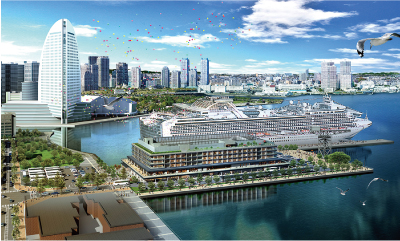
Shinko Pier perspective drawing
Shinko Pier is set to undergo major changes in the fall of 2019.
The passenger terminal we be redeveloped as an integrated food-themed hands-on experience type commercial facility and hotel through a collaborative project with citizens. This will attract even more people to the Port of Yokohama in the future.
Silk scarfs, a local industry in Yokohama with a prestigious history
When the Port of Yokohama opened, raw silk became a key commodity for trade in Yokohama, attracting many side workers and dyers. Because of this, silk scarfs went on to become a local industry in Yokohama. Yokohama’s silk scarfs are held in high esteem around the world; when the industry was in its heyday, silk scarfs from Yokohama accounted for over half of global production volumes.
The Silk Museum, located in Yamashita-cho, provides visitors with a chance to learn about raw silk in detail, and also holds events and thematic exhibitions for children, so please stop by to have fun.
Our wish is to uphold the traditions of Yokohama scarfs while generating new styles suited to the times, spreading awareness of the charms of these scarfs among as many people as possible.

Mr. Toshiyuki Matsumura
Chairman, Yokohama Textile Association
April Issue - A shopping street where you can enjoy viewing cherry blossoms in spring
Naka Ward, a great place to live, work or visit, aims to encourage regional revitalization by improving its appeal through community development which utilizes the area’s characteristics, while ensuring safety and security for all. 2019 marks the 160th anniversary of the opening of the Port of Yokohama, as well as being a year for major events, including Garden Necklace Yokohama 2019 and Rugby World Cup 2019TM. As such, this is the perfect time for Naka Ward to take steps to improve accessibility within the ward and create the kind of vibrant community filled with vitality.
At the same time, ever since the port first opened, Naka Ward has developed as a community in cooperation with people from overseas. Therefore, the ward is also working with related organizations to promote multicultural community development, enabling both Japanese and foreign nationals to live here together in peace of mind.
[Inquiries] Kusei Suishin-ka (Ward Administration Promotion Division, Naka Ward Office)
1. Creation of a vibrant community filled with vitality
We aim to ensure that Naka Ward is an attractive place for all by improving accessibility, such as by promoting the ward’s shopping streets, creating community-led vibrancy, and encouraging people to rediscover the charms of the wards areas of rivers. In addition, we will create vitality and good health for the town and its people through initiatives run as a collaboration between local activities and cultural, arts and sports events.
● Projects to promote community development
We will work to improve accessibility through such means as facilitating attractive events using the “Guide to holding Events along Nihon Odori Street,” which was revised in 2018, encouraging people to rediscover the charms of the Ookagawa River area.
● Projects to promote regional cooperation
Taking the Honmoku area as a model, we are working with the community to promote the attractions of Honmoku and revitalize this area in cooperation with a range of local stakeholders.
● Projects to improve the appeal of the ward’s shopping streets
We have created a video showcasing the appeal of the ward’s shopping streets, which we have uploaded to YouTube and other platforms as part of a PR drive for the area.

Rediscovering the charms of the Ookagawa River area (E-Boat experience)
2. Community development which provides mutual support for people of all ages and backgrounds, from children to senior citizens
We will work to put in place the kind of environment in which children can grow up in good health and parents can enjoy raising their children, as well as take steps to encourage senior citizens to participate in society and prevent them from having to enter into care. In addition, we will provide support to help those in need regain their independence, generate awareness of disabilities, and promote mutually supportive community development that enables anyone to live in this ward in peace of mind.
● Nakanaka iine! Work to promote Naka Ward Regional Social Welfare and Health Plan
This 3rd-term plan enters into its 4th year this fiscal year. Together with all local residents, we aim to put this plan into action and create a pleasant community for all. We will also draw up the 4th-term plan based on the results of such things as group interviews and opinion polls conducted among ward residents.
★ Project to support cafeterias for children (new)
Through the Kodomo Shokudo Network, a grass-roots movement bringing together activists, businesses and other concerned parties in an effort to set up cafeterias to feed disadvantaged children, we will provide support for sustainable activities by exchanging and sharing pertinent information. In addition, we will conduct questionnaire surveys to ascertain the living conditions of children and their needs.

Inaugural meeting of the Kodomo Shokudo Network
3. Safe and secure community planning which allows people to live in good health
We will take steps to generate an awareness of self-help and mutual assistance, support those in need of special help in times of disaster, and take measures concerning pets, thus improving Naka Ward’s community disaster resilience. In addition, we will steadily implement measures to protect the daily lives of residents, including traffic safety measures for children and senior citizens, measures to combat the problem of abandoned bicycles, and assistance with local voluntary crime prevention activities.
● Projects to improve community disaster resilience
We will work to train people who can assume responsibility for raising awareness of disaster mitigation among a wide range of generations, focusing on disaster prevention attractions, and provide assistance in times of disaster. In addition, we will also seek to improve the ward’s community disaster resilience at local disaster prevention centers by diversifying the means of communicating information during times of disasters, and running drills that incorporate a wide range of needs, including the perspectives of women.

Drill in progress at a local disaster prevention center
4. Community development based on multiculturalism
We will promote the kind of community development which enables both Japanese and foreign nationals to live side by side in peace of mind as residents of the same community. In addition, Naka Ward Office as a whole will seek to improve its services for foreign nationals, such as by providing a greater range of information along with counter and consultation services in different languages, as well as initiating educational and awareness drives among residents of Naka Ward on multiculturalism in the community.
● Projects to promote multicultural exchanges
We will promote community development rooted in multicultural coexistence through cooperation between foreign communities and local organizations, schools etc., centering on Naka International Lounge. In addition, we will work to develop future human resources by creating places for young people with roots overseas to go.

Presentation session on the activities of “Nijiiro Tankentai,” a group formed by young people with roots overseas (Multicultural Festa)
5. Creating the kind of ward office that works side by side with the local community
In order to help create a vibrant and flourishing town, we work side by side with the local community, listening carefully to what residents have to say. We also provide day to day administrative services in a plain and easy to understand way, ensuring both accuracy and speed, striving to create the kind of ward office that all ward residents can use at ease.
● Projects to create an accessible ward office
We aim to be a more accessible ward office to visitors, a government office that is easy to understand, easy to use and comfortable. In addition to improving the building’s layout and updating its facilities, we also aim to be a familiar ward office among local residents through work intended to improve the building’s exterior and grounds
March Issue - A shopping street where you can enjoy viewing cherry blossoms in spring
March is the season of cherry blossoms. It is also the month when Garden Necklace YOKOHAMA 2019 begins.
This is the season when the town is ablaze with the colors of flowers and new greenery, so why not go out for the day to a shopping street which is located right next door to some renowned cherry blossom viewing sites? Here, you can find a range of items suited to the season, as well as other wonderful products made by the shopkeepers with love. This is a shopping street which has supported our daily lives and the local community for generations, serving to bring people together. It is a very friendly place with much charm waiting to be explored.
Kyodo Kumiai Motomachi SS Kai (Yokohama Motomachi Shopp ing Street Association)
Motomachi Shopping Street boasts over 200 different stores, and has developed over the years thanks to a spirit of mutual assistance between these stores. The shopkeepers in this thriving shopping street are united in introducing customers to each other’s stores and providing products suited to seasonal events.
I opened this cookery school here in my beloved Motomachi 20 years ago. We are mainly a cookery school and French confectionary store, but on Saturdays, Sundays and national holidays, we are also open as a tea room.

Recommendations
Cherry blossom honey Castella, nougat, honey crème caramel pudding with cherry blossom
Castella and nougat made using local Motomachi honey.
Eiko Morita (French confectionary store / cookery school)
Address: Tanaka Building 2F, 1-21-2 Motomachi Tel. 045-681-6155
Honmoku cherry blossom viewing tour
The Honmoku area has many excellent places to view cherry blossoms, such as Honmoku Sancho Park, Sankeien Garden, and Yamate Park. So why not enjoy a stroll around Honmoku while searching for cherry blossoms.
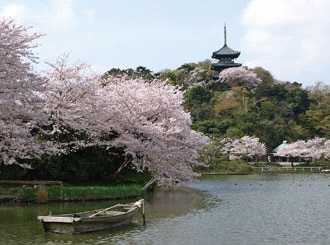
Sankeien Garden
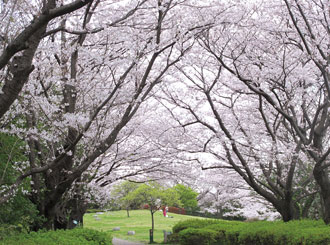
Honmoku Sancho Park
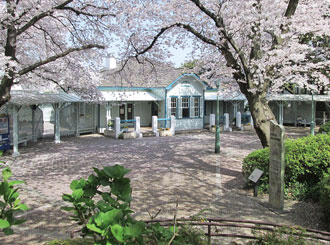
Yamate Park
Honmoku Sancho Park
Please come along and enjoy an open air tea ceremony underneath the cherry blossoms to the accompaniment of a traditional Japanese music performance by children.
Date: 4/6 (Sat.) *4/7 (Sun.) in the event of rain
- Traditional Japanese music performance by local children: 11:00 – 11:30 (Wada Hayashiren), 12:30 – 13:00 (Hongo Hayashiren)
- Open air tea ceremony (Urasenke school): 11:00 – 14:00, \500, limited to 50 people of a first come first served basis
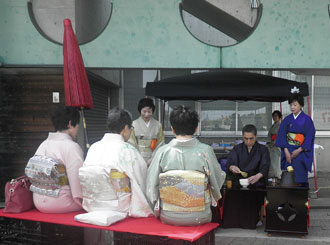
Venue / inquiries: In front of Honmoku Sancho Park Rest House (Wada-Yamaguchi bus stop)
Tel. 045-622-2766
Mugitacho Hatten-kai (Mugitacho Development Association)
Long standing shops and new stores get together to hold a range of events, such as baked sweet potato festivals and Halloween parties, thus bringing new vitality to this area of town. This was the first shopping street in Japan to introduce FA Project Emergency First Aid Kits* for use in accidents and times of disaster, a measure taken with the aim of improving safety in the local community.
We recommend you to climb the slope behind the stores, where you can enjoy the cherry blossoms in Yamate Park and, a little further on, at Sankeien Garden, too. In both parks, the cherry blossoms look beautiful lit up at night. On your way back from these parks, please stop off to sample some delicious yakitori grilled chicken and experience true service with a smile.
* Under this scheme, you can receive an emergency first aid kit in times of need.
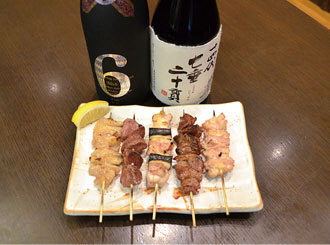
Recommendations
Yakitori
The chef grills each and every stick of his exquisite yakitori chicken over binchotan, a type of high-grade charcoal produced from ubame oak. Yakitori is available for takeout, making it the perfect companion for a spot of cherry blossom viewing.
Yakitori Matoi
Address: 2-59 Mugita-cho Tel. 045-623-9440
Ookagawa Sakura Festival
This festival, set amidst rows of cherry trees lining the Ookagawa River, hosts a range of events which allow visitors to enjoy the river and cherry trees to the full, such as live music performed on barge-based stages floating in the river, boat boarding experiences and nighttime cherry blossom shows. You will also find a variety of food stalls with a cosmopolitan feel, run by local neighborhood associations, etc.
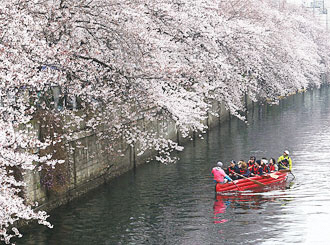
Main events
Dates and times: 3/30 (Sat.) – 4/1 (Mon.), 11:00 – 16:00
Venues: Fukutomicho Nishi Park, Ookagawa Sakura Pier, Yokohama Hinode Pier, various neighborhood associations, etc.
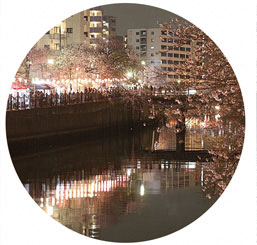
Bonbori paper lanterns
Dates and times: 3/23 (Sat.) – 4/14 (Sun.), 17:00 – 24:00
Venues: Miyako Bridge – Sakae Bridge
Hinodecho Eki-mae Shotenkai (Hinodecho Station Front Store Association)
This year is the 27th Ookagawa Sakura Festival, an established event in the area. This event originated with the Ookagawa Flower Festival, an initiative run by the Hinodecho Station Front Store Association with the aim of revitalizing the local community. From there, it developed into today’s Ookagawa Sakura Festival thanks to the ever-increasing participation of stores from the shopping street and neighborhood associations.
You can get good views of the Ookagawa River from the stores. In recent years, you can also see people enjoying themselves on the river in SUP.* And we are very happy to report that many customers believe that Gurebi boasts the best views of cherry blossoms in town!
* SUP, or standup paddleboarding, is an activity in which people stand on a board and propel themselves across the water’s surface using a paddle.
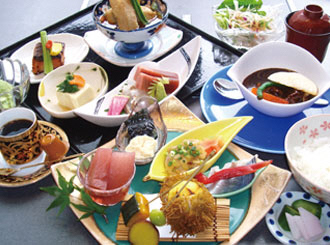
Recommendations
Hana Yuzen (reservation required)
A set menu fusing Japanese and Western styles of cuisine. With a range of seasonal appetizers, you can enjoy different dishes throughout the year. The spring menu includes such items as fresh Japanese mackerel, spring vegetable tempura, and cherry blossom ice cream.
Yuzen Gurebi
Address: Hinodecho Post Office Building 2F, 1-24 Hinodecho Tel. 045-252-7315
The shopping street, a place for communication which brings people together
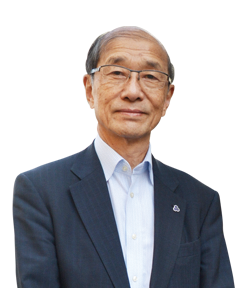
Shopping streets are familiar places where you can go to buy things and interact with all kinds of people. Not only do they help enliven areas through the staging of various events etc., but they also contribute to the safety and peace of mind of communities through such things as the maintenance of streetlights and security patrols.
The Naka Ward Shopping Street Association collaborates with Naka Ward Office to create a range of PR videos showcasing various shopping streets, with the aim of introducing more people to the benefits of shopping streets.
The shopping streets introduced here are just a small fraction of the many exciting shopping streets just waiting to be explored. We will continue working hard to promote the shopping streets and stores of various areas, so please show your support by making a visit to one soon.
Mr. Shoichi Kato, Chairman of the Naka Ward Shopping Street Association
ページID:977-153-025
